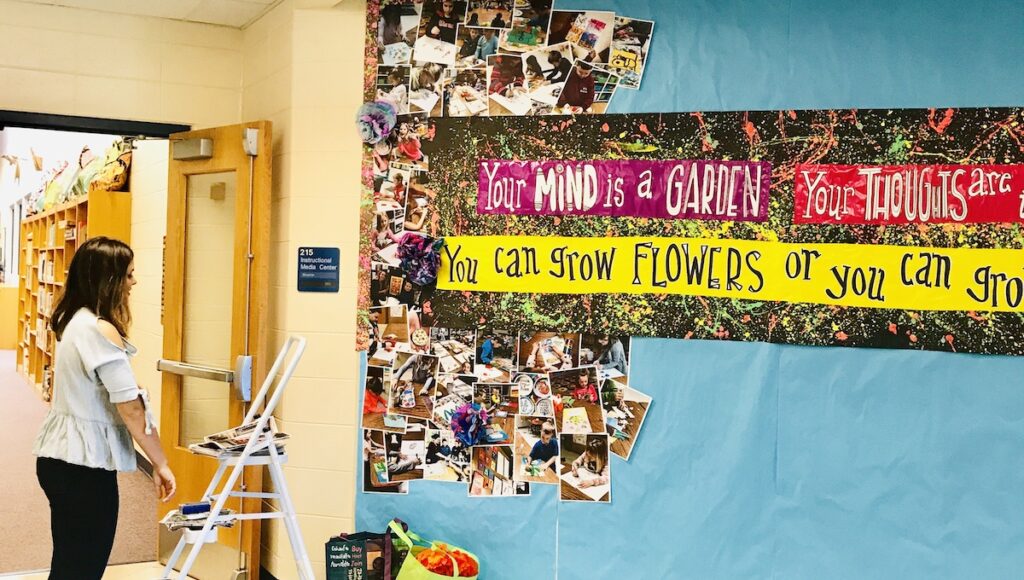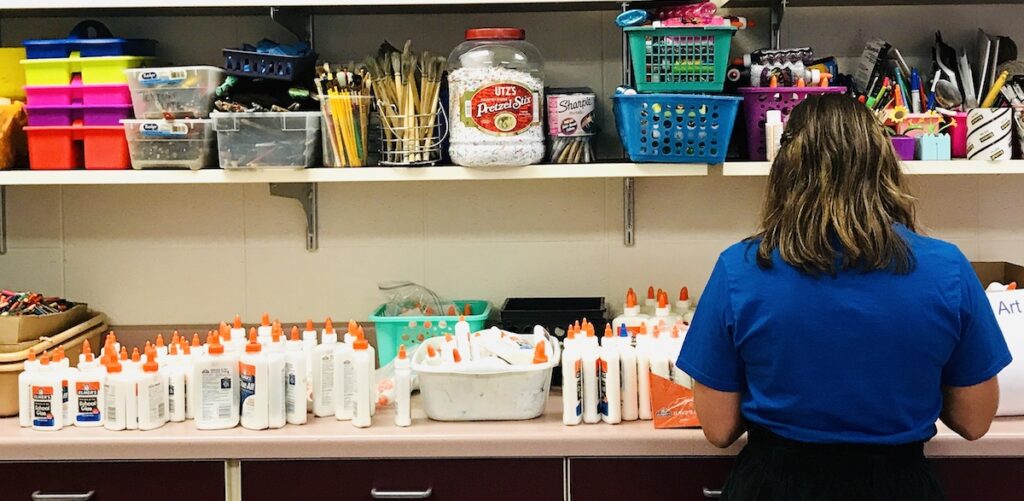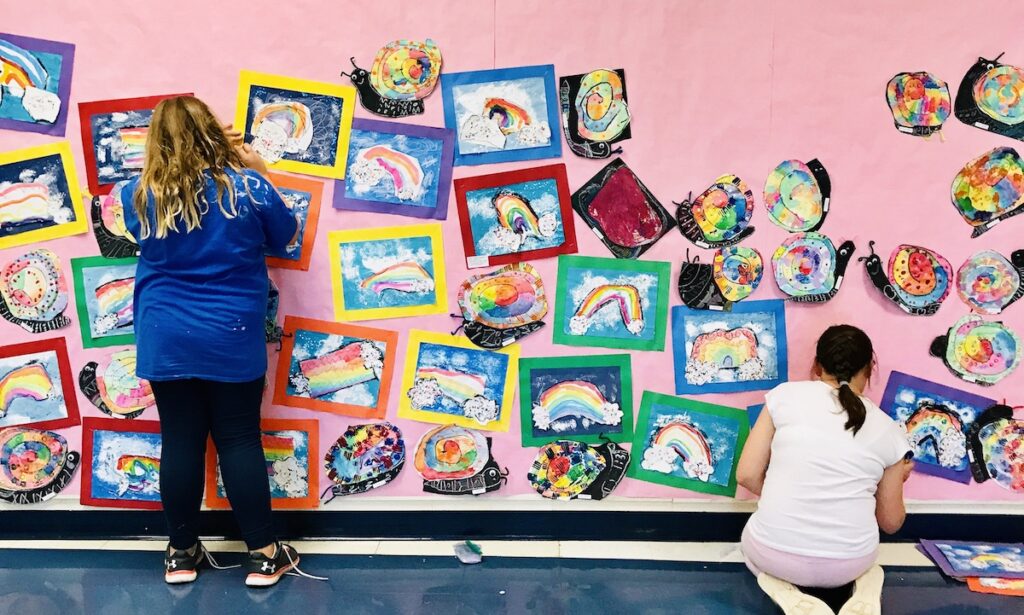Does the thought of people helping in your art room excite you or stress you out?
These amazing humans, also known as volunteers, can really be a great asset to your art program if you know how to use them! If you’re lucky, you may already have a few passionate parents or guardians who have asked if you would like help in your classroom. Now, before you freak out about the idea of strangers rifling through your precious stacks of artwork, let’s talk about the benefits of using these integral members of your school community.
1. Advocate For Your Program
You can say as many positive things as you want about your own classroom. Of course, you believe in what you do! However, one of the best ways to advocate for the amazing things you are doing with kids is to have others say it. When someone else steps into your room, they see first hand how kids are creating, collaborating, practicing problem-solving skills, and having fun. Having a team of people who understand the value of your classroom is an incredible benefit. These individuals will be a constant advocacy team for you, your school, and your artists.

2. Manage Tedious Work Tasks for the Teacher
There is no set rule about how many art displays we need to hang in the hallway or about how many digital photos to upload to our students’ online art portfolios. We set these high expectations for ourselves, and though each of these fantastic additions to our program is important, sometimes it can be a lot. This is where your volunteers can help you manage some of those time consuming extra tasks. Let’s face it; you are passionate about the extra things you do to go above and beyond for your students, so you don’t want to stop doing them. But there’s only one you. It is not a weakness to ask for help.
Creating a running list of simple to-do tasks is the best way to manage help from volunteers. Think of what you spend most of your time doing during your prep time. Can any of these tasks be delegated to another qualified individual?
Here are a few suggestions for simple tasks that might be perfect for a volunteer:
- Label artwork with student name stickers
- Mount completed projects onto colored backgrounds
- Organize or photograph artwork for online student portfolios
- Refill supplies such as glue bottles or paint trays
- Hang artwork in hallways
- Prep materials like cutting templates, photos, or stencils
Admittedly, sometimes it can be hard to give up a little control in your art room. It can be really fun to put up a new display of artwork in the hallway or relaxing to cut all the laminated sketchbook covers! However, you need to consider what is the best use of your time.

3. Build a Strong Parent/Guardian Connection for Teacher and Students
You are a fantastic role model for your students. Allowing more amazing role models in your classroom to interact with your students is a great asset. Students can see that teachers and parents or guardians work together. You will likely make some lifelong friends with the families of volunteers in your classroom.
4. Help with Classroom Management
If your art room helpers are comfortable interacting with students during class time, it can be a great way to take advantage of having another set of eyes to help manage the behavior of your students.

If you’re looking for more awesome ideas about how to connect with volunteers, check out this article, 5 Ways to Build Better Relationships with Parents.
Now that you know some of the benefits of having volunteers in your classroom, how do you find the right people?
To find out who is willing to join in your amazing world of art, try these tips:
- Add a “Volunteers Needed” request to your school newsletter. If you create any type of “Art Room Newsletter,” this is a great place to get the word out to let interested individuals know that you are willing to accept volunteers. This is especially helpful if you are looking for parent or guardian volunteers.
- Email high school students who may need volunteer hours to see if they want to come help in your classroom. This is especially fun if you have been working at one location long enough to have had those students as your own at one time!
- If you teach at the elementary level, you can also ask eager students if they are interested in helping with art room tasks!
As you start to think about more people joining your art environment, be sure to set appropriate expectations with volunteers.
According to the Responsive Classroom, here are a few suggestions to make sure volunteers can be successful:
- Set expectations. Be clear about what you anticipate the volunteer role will entail.
- Share classroom rules and routines. Be sure your volunteers (parents, guardians, or students) know the rules of your room.
- Ask that volunteers maintain children’s privacy. Ensure volunteers respect the student’s creative and mental process.
- Include a reminder about voice level. Sometimes adult voices carry more than students, so be sure to be clear about what volume is appropriate.
- Maintain consistent discipline. Let the volunteer know you are there to deal with discipline questions or issues with students.
- Give volunteers non-teaching roles. Volunteers are there to help passionately and should not take over your roles.
- Put your expectations in writing. A written reminder may be nice for maintaining consistent expectations.
- Try to involve all students’ parents and guardians in some way. Even if only a few parents or guardians come into the classroom to volunteer regularly, you can still update everyone through newsletters, social media, school emails, and more. Everyone wants to know what’s happening in the art room!
As your year gets underway, think about how including volunteers could help lighten your load and build an even more engaging environment for students. It might be time to welcome these untapped volunteer resources in your art room!
How can you see using volunteers in your art room?
Do you use students as helpers for extra art room tasks?
What other benefits might there be from welcoming community members into your art world?
Magazine articles and podcasts are opinions of professional education contributors and do not necessarily represent the position of the Art of Education University (AOEU) or its academic offerings. Contributors use terms in the way they are most often talked about in the scope of their educational experiences.





